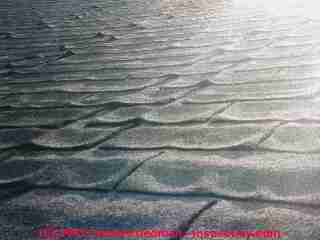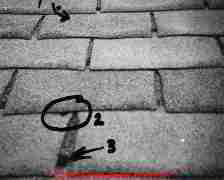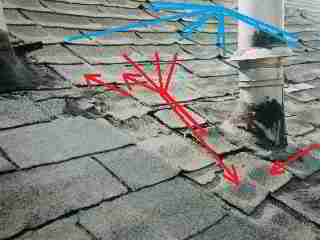 Asphalt Shingle Cupping & Clawing, Signs of Roof Shingle Wear
Asphalt Shingle Cupping & Clawing, Signs of Roof Shingle Wear
- POST a QUESTION or COMMENT about shingle cupping: causes, remedy, types of roofs where cupping asphalt shingles are most often found, impact on remaining roof life
Cupping asphalt shingles:
This article series describes cupped asphalt roofing shingles and how to identify & explain the most-common asphalt roof shingle failures. These cupping shingle defects occur on both organic-mat and fiberglass-mat asphalt roof shingles, but are more common on organic mat asphalt shingle roofs.
We describe the difference between shingle cupping & shingle curling - which can be important in diagnosing the cause of early roof wear or damage. And we warn against walking on cupped shingle roofs. Readers are also invited contribute roof failure information to the web author for research purposes. web author for research purposes.
InspectAPedia tolerates no conflicts of interest. We have no relationship with advertisers, products, or services discussed at this website.
- Daniel Friedman, Publisher/Editor/Author - See WHO ARE WE?
Cupping & Clawing Asphalt Shingle Explanation & Photos

The roof shingles shown above are described by some inspectors as "curling" but as the shingle centers are clearly concave, I describe these as "cupped". In fact it's fair to say that both cupping and curling are present on this organic-mat asphalt shingle roof that is now fragile and at the end of its life. As you'll read in a moment, some even call this roof condition "clawing".
Watch out: Don't walk on this roof unless you're prepared to explain leaving a trail of broken shingle fragments to show where you stepped.
See ROOF INSPECTION SAFETY & LIMITS
[Click to enlarge any image]
Definition of Asphalt Shingle Cupping
Cupping asphalt roof shingles, particularly on organic or felt-based asphalt shingles, are a normal wear pattern that shows up with shingle age.
Cupped asphalt shingles are show in our page top photo and in others on this page. In our photo (left) the top arrow in the photo at left points to the left side of a "cupped" area of this roof shingle. The shingle edges are also curled in these photos, which is part of this wear pattern.
This "normal" cupping or curling pattern will display shingles which are concave in their center, with the corners and possibly the three exposed shingle tab edges curled such that the very edge of the shingle curls downwards.
Definition of Asphalt Shingle Clawing
"Clawing" is also used to describe the appearance of asphalt roof shingle corners that curl down and under (photos above and below). Marshall et als (1999) observed:
Cupping and clawing results from asphalt shrinkage on the top and bottom surfaces of the shingles, respectively. The corners and edges of the shingles are prone to curling or cupping as the mat shrinks. Crazing of the shingle surfaces also results from asphalt shrinkage. Eventually, chunks of granules flake away from the mat leaving the asphalt coated mat exposed to the weather. - Marshall et als (1999)
Common Asphalt Shingle Wear Indicators are often combined on a single roof
Shingles in this condition are fragile and nearing end of life. In this condition, if someone walks on cupped shingles the raised cupped sections will break and can lead to early failure and leaks.
Our photo (left) shows that on the right-hand roof, virtually all of the shingles are cupped (red arrows & lines) and the shingles are also fish-mouthed. The staggering of fish mouthing on the roof is consistent with the location of shingle butt joints in successive courses.
Asphalt roof shingles as they wear either normally or in some cases at an accelerated (early failure) rate, often show one of the following wear signs, but as our photo at left illustrates (both cupping & curling) shingles can show any or all of these wear signs in combination as well.
- Cracking shingles - fine or wide cracks through the shingle surface and into or through the shingle body
- Cupping / clawing shingles - the roof shingles develop a concave center (discussed here)
- Curling shingles - raised shingle edges which curl downwards)
- Fishmouthing shingles - raised edge of a shingle tab at its center with little curling , most often over the butt-joint of two shingles in the course below
- Granule loss from shingle surfaces - the mineral granules are washing off of the shingle surface, exposing bald shingle substrate below. Granule loss may also occur from foot traffic, mechanical damage, or hail damage.
Each of these asphalt roof shingle conditions is different in appearance and while all of them may indicate worn, old, or fragile roof coverings, their causes and prevention vary. In some of the photos of cupped roof shingles on this page, "fishmouthing" is also visible (see photo at page top). It is common for multiple wear signs to be present at once.
Cupped roof shingles are fragile: You should avoid walking on cupped-shingle roofs, particularly in cold weather (shingles are more likely to break).
As you can see in our photo (left) the raised fishmouth section of the cupped shingles is already cracking on its own. Stepping on this raised point (blue arrow) or on the raised area of the cupped shingle (red arrow) is likely to break it, converting a worn-out roof into one that is actively leaking.
Watch out: If we absolutely have to walk on such a roof, we would tiptoe carefully, avoiding stepping on the raised or cupped shingle sections, or if doing repairs, we would prop a ladder up off of the roof surface and work from that scaffold as is sometimes done with slate or other fragile roof surface repairs.
Walking on a cupped shingle roof can cause irreparable damage: Take this warning seriously: an old cupped asphalt shingle roof may not yet be leaking and could last several more years depending on its condition.
But we have seen cupped asphalt shingle roofs that had been destroyed by the "inspector" who walked all over the roof, breaking shingles everywhere he stepped, leaving a trail of damage and leading to the need for an immediate roof replacement. The roof would have needed replacement soon before the "inspection."
After the "inspection" the roof needed immediate replacement. we could actually see the "footprints of destruction" across the roof surface.
See ROOF INSPECTION SAFETY & LIMITS
Research Citations for Asphalt Shingle Cupping & Clawing
- Also see our research citations atReferences or Citations
- Bailey, David M. Roofer: Steep Roofing Inventory Procedures and Inspection and Distress Manual for Asphalt Shingle Roofs. No. CERL-TR-99/100. CONSTRUCTION ENGINEERING RESEARCH LAB (ARMY) CHAMPAIGN IL, 1999.
- Cash, CARL G. "Asphalt roofing shingles." In Proceedings of the 11th Conference on Roofing Technology, National Roofing Contractors Association, Rosemont, Illinois, pp. 1-9. 1995.
- Cullen, WILLIAM C. "Research and performance experience of asphalt Shingles." In 10th Conference on Roofing Technology, vol. 7. 1993.
- Cullen, William C. "The Evolution of Aspahlt Shingles: Survival of the Fittest?." Professional Roofing (1992).
- Dunlop, Carson. Essentials of Home Inspection: Home Reference Book. Dearborn Real Estate, 2003.
- Dunlop, Carson. Principles of Home Inspection: Roofing. Vol. 5. Dearborn Real Estate, 2003.
- Dunlop, Carson. Principles of Home Inspection: Systems & standards. Review questions & answers. Vol. 15. Dearborn Trade Publishing, 2003.
- "Hail Damage to Asphalt Roof Shingles", Timothy P. Marshall, Richard F. Hertzog, Scott J. Morrison, Haag Engineering, Dallas TX,
- Greenfeld, S.H., 1969: Hail resistance of roofing products, Building Science Series #23, National Bureau of Standards, 9 pp. Koontz, J.D., 1991: The effects of hail on residential roofing products, Proc. of the Third International Symposium on Roofing Technology, NRCA/NIST, 206-215.
- Ilnyckyj, Peter. "Shingles." U.S. Patent 5,442,888, issued August 22, 1995.
- Koontz, Jim D. "The effects of hail on residential roofing products." In Proceedings of the Third International Symposium on Roofing Technology,” NRCA/NIST. 1991.
- Lockinger, Paul. Understanding a Home Inspection. Florian Valentine Publishing, 2009.
- Marshall, Timothy P., Richard F. Herzog, and Scott J. Morrison. "Hail Damage to Asphalt Roof Shingles." In 22nd Conference on Severe Local Storms. 2004.
- McNulty, Raymond A. "[Asphalt Roof Shingle] COMPOSITION, PERFORMANCE, FUNCTION, AND STANDARDS." Interface (2000).
- Morrison, S.J., 1999: Long-Term Effects of Hail on Asphalt Composition Shingles Proc. of the North American Conf. on Roofing Technology, Toronto, Canada, 30-39.
- Noone, MICHAEL J., and W. KENT Blanchard. "Asphalt Shingles–A Century of Success and Improvement." In Proceedings of the 10th Conference on Roofing Technology, pp. 23-33. 1993.
- Ribble, R. E. I. D., R. I. C. K. Olson, D. Summers, and J. O. N. A. T. H. A. N. Goodman. "From generation to generation: issues and problems facing the steep-slope roofing industry." In Proc. of the 10th Conf. on Roofing Technology, vol. 1, no. 5. 1993.
...
Reader Comments, Questions & Answers About The Article Above
Below you will find questions and answers previously posted on this page at its page bottom reader comment box.
Reader Q&A - also see RECOMMENDED ARTICLES & FAQs
Question: why are shingles on my new roof cupping ?
Why is my new Roof cupping and it is only 2 weeks old? Yes Two weeks? - Joyce 11/28/11
Reply:
Cupping of brand new roof shingles would be unusual. It might occur if shingles were installed over a wet roof deck or over an old layer of cupped, curled, or wet roof shingles.
Use the CONTACT link found at page top, left, or bottom to send us some sharp photos of the roof including some closeups and photos from a low angle that shows the cupping and we may be able to comment further.
Question: My 25-year warrant asphalt shingles are cupping after 13 years
I have a situation where my asphalt shingles have a 25 year material warranty and were installed 13 years ago. A large portion of the shingles are now cupping. The roof is a very simple hip roof with a single gable and one valley.
Why are the shingles failing at approximately half of their life?
Should the shingle manufacturer be held liable for the early product failure? Will they actually honor this material warranty? - Scott S. 3/12/12
Reply:
Scott, shingle warranty claims are honored by manufacturers based in part on the manufacturer's assessment of the nature of the problem and their determination of whether the problem is due to faulty product or due to other problems such as a faulty installation or a structural or roof venting problem. You will want to contact the manufacturer and ask them to take a look at the roof, and
- First, agree that there is a problem that affects the anticipated roof life
- Second, name and define the problem
- Third: state an opinion about its cause
- Third: provided they agree that the problem is not just cosmetic, indicate if the roof warranty applies
- Fourth: give you details of what warranty coverage is actually provided. Typically warranties cover a pro-rated portion of product cost and often labor is excluded.
...
Continue reading at CURLING ASPHALT SHINGLES or select a topic from the closely-related articles below, or see the complete ARTICLE INDEX.
Or see these
Recommended Articles
- ASPHALT SHINGLE FAILURE TYPES
- ASPHALT SHINGLE LIFE / WEAR FACTORS
- ASPHALT SHINGLES on LOW SLOPE ROOFS
- ASPHALT ROOF SHINGLES - topic home, for all articles about asphalt roof shingles
- BUCKLED ASPHALT SHINGLES
Suggested citation for this web page
CUPPING ASPHALT SHINGLES at InspectApedia.com - online encyclopedia of building & environmental inspection, testing, diagnosis, repair, & problem prevention advice.
Or see this
INDEX to RELATED ARTICLES: ARTICLE INDEX to BUILDING ROOFING
Or use the SEARCH BOX found below to Ask a Question or Search InspectApedia
Ask a Question or Search InspectApedia
Try the search box just below, or if you prefer, post a question or comment in the Comments box below and we will respond promptly.
Search the InspectApedia website
Note: appearance of your Comment below may be delayed: if your comment contains an image, photograph, web link, or text that looks to the software as if it might be a web link, your posting will appear after it has been approved by a moderator. Apologies for the delay.
Only one image can be added per comment but you can post as many comments, and therefore images, as you like.
You will not receive a notification when a response to your question has been posted.
Please bookmark this page to make it easy for you to check back for our response.
IF above you see "Comment Form is loading comments..." then COMMENT BOX - countable.ca / bawkbox.com IS NOT WORKING.
In any case you are welcome to send an email directly to us at InspectApedia.com at editor@inspectApedia.com
We'll reply to you directly. Please help us help you by noting, in your email, the URL of the InspectApedia page where you wanted to comment.
Citations & References
In addition to any citations in the article above, a full list is available on request.
- .../LI>
- Our recommended books about building & mechanical systems design, inspection, problem diagnosis, and repair, and about indoor environment and IAQ testing, diagnosis, and cleanup are at the InspectAPedia Bookstore. Also see our Book Reviews - InspectAPedia.
- Asphalt Roofing Residential Manual from ARMA the Asphalt Roofing Manufacturers Association Website https://www.asphaltroofing.org/product/residential-asphalt-roofing-manual/ ,
- Building Pathology, Deterioration, Diagnostics, and Intervention, Samuel Y. Harris, P.E., AIA, Esq., ISBN 0-471-33172-4, John Wiley & Sons, 2001 [General building science-DF] ISBN-10: 0471331724 ISBN-13: 978-0471331728
- Building Pathology: Principles and Practice, David Watt, Wiley-Blackwell; 2 edition (March 7, 2008) ISBN-10: 1405161035 ISBN-13: 978-1405161039
- Roof failure causes in depth (and specific methods for avoiding them)
- Roof design fundamentals and flourishes, based on voluminous industry research and experience
- In addition to citations & references found in this article, see the research citations given at the end of the related articles found at our suggested
CONTINUE READING or RECOMMENDED ARTICLES.
- Carson, Dunlop & Associates Ltd., 120 Carlton Street Suite 407, Toronto ON M5A 4K2. Tel: (416) 964-9415 1-800-268-7070 Email: info@carsondunlop.com. Alan Carson is a past president of ASHI, the American Society of Home Inspectors.
Thanks to Alan Carson and Bob Dunlop, for permission for InspectAPedia to use text excerpts from The HOME REFERENCE BOOK - the Encyclopedia of Homes and to use illustrations from The ILLUSTRATED HOME .
Carson Dunlop Associates provides extensive home inspection education and report writing material. In gratitude we provide links to tsome Carson Dunlop Associates products and services.



